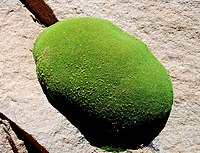bio.wikisort.org - Plant
Yareta or llareta (Azorella compacta, known historically as Azorella yareta, from yarita in the Quechua language) is a velvety, chartreuse cushion plant in the family Apiaceae which is native to South America. It grows in the Puna grasslands of the Andes in Peru, Bolivia, northern Chile and western Argentina at altitudes between 3,200 and 5,250 metres (10,500 and 17,220 ft).[1][2]

Description
Yareta is an evergreen perennial with a low, mat-like shape and hemispherical growth form that grows to around 6 m (~20 ft) in diameter.[3] The self-fertile, pink or lavender flowers are hermaphroditic and are pollinated by insects.[citation needed]
The plant prefers sandy, well-drained soils. It can grow in nutritionally poor soils that are acidic, neutral or basic (alkaline) at altitudes of up to 5,200 metres (17,100 ft).[2] Yareta is well-adapted to high insolation rates typical of the Andes highlands and cannot grow in shade. The plant's leaves grow into an extremely compact, dense mat that reduces heat and water loss.[4] This mat grows near the ground where air temperature is one or two degrees Celsius higher than the mean air temperature. This temperature difference is a result of the longwave radiation re-radiated by the soil surface, which is usually dark gray to black in the Puna.[4]
Yareta is estimated to grow approximately 1.5 centimetres (0.59 in) per year.[2] Many yaretas are estimated to be over 3,000 years old.[5] These oldest ones have been reported to grow as slowly as 1/18th inch (1.4 millimeters) per year.[6] Its very slow growth makes the traditional practice of harvesting it for fuel highly unsustainable.[7]
Gallery
- Plant in crevice in Eduardo Avaroa Andean Fauna National Reserve, Potosí, Bolivia
- Close-up showing seeds
- Texture of surface
- Flowers
References
- "Image of Azorella compacta". chileflora. Retrieved 28 October 2015.
- Kleier, Catherine; Rundel, Philip W. (August 2004). "Microsite requirements, population structure and growth of the cushion plant Azorella compacta in the tropical Chilean Andes". Austral Ecology. 29 (4): 461–470. doi:10.1111/j.1442-9993.2004.01386.x.
- Pugnaire, Francisco I.; Morillo, José A.; Rodríguez-Echeverría, Susana; Gaxiola, Aurora (February 2020). "Azorella compacta : survival champions in extreme, high‐elevation environments". Ecosphere. 11 (2). doi:10.1002/ecs2.3031.
- Wickens, G. E. (April 1995). "Llareta (Azorella Compacta, Umbelliferae): A review". Economic Botany. 49 (2): 207–212. doi:10.1007/BF02862926. ISSN 0013-0001. S2CID 37079723.
- Stenger, Richard (2019-11-28). "The oldest living things on Earth". CNN Travel. Retrieved 2020-01-09.
- Ralph, Carol P. (March 1978). "Observations on Azorella compacta (Umbelliferae)". Biotropica. 10 (1): 62 plus photo p. 63. doi:10.2307/2388107. JSTOR 2388107.
- "See the world's oldest organisms".
External links
 Media related to Azorella compacta at Wikimedia Commons
Media related to Azorella compacta at Wikimedia Commons- Azorella compacta pictures from Chile
На других языках
- [en] Yareta
[es] Azorella compacta
Azorella compacta, conocida comúnmente como llareta o yareta (o yarita, del kunza), es una especie fanerógama de la familia Apiaceae; nativa de Sudamérica.[ru] Ярета
Ярета (лат. Azorella compacta) — вид крошечных цветковых растений из рода Азорелла семейства Зонтичные.Другой контент может иметь иную лицензию. Перед использованием материалов сайта WikiSort.org внимательно изучите правила лицензирования конкретных элементов наполнения сайта.
WikiSort.org - проект по пересортировке и дополнению контента Википедии




